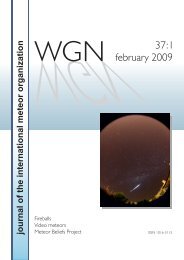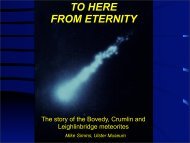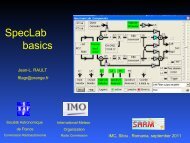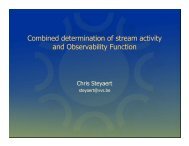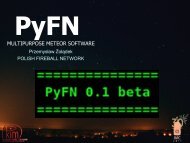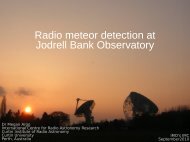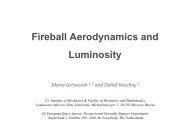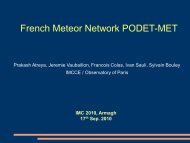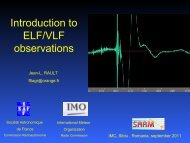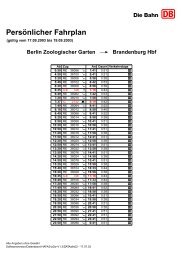BRAMS : the Belgian RAdio Meteor Stations
BRAMS : the Belgian RAdio Meteor Stations
BRAMS : the Belgian RAdio Meteor Stations
Create successful ePaper yourself
Turn your PDF publications into a flip-book with our unique Google optimized e-Paper software.
<strong>BRAMS</strong> :<br />
<strong>the</strong> <strong>Belgian</strong> <strong>RAdio</strong> <strong>Meteor</strong> <strong>Stations</strong><br />
A new facility to detect and<br />
characterize meteors<br />
Hervé Lamy & Stijn Calders<br />
<strong>Belgian</strong> Institute for Space Aeronomy
Overview<br />
• Radio meteor observations: forward scattering<br />
• Description and status of <strong>BRAMS</strong><br />
• Scientific goals of <strong>BRAMS</strong><br />
• Future and perspectives
RADIO FORWARD SCATTERING<br />
OBSERVATIONS OF METEORS
Radio forward-scattering observations<br />
Duration of <strong>the</strong> « meteor<br />
echo » depends on <strong>the</strong><br />
lifetime of <strong>the</strong> electron<br />
trail released in <strong>the</strong><br />
wake of <strong>the</strong> meteoroid<br />
(from a fraction of a<br />
second up to a few<br />
minutes) and of <strong>the</strong><br />
sensitivity of <strong>the</strong><br />
receiver<br />
φ φ
<strong>BRAMS</strong>: <strong>the</strong> <strong>Belgian</strong> <strong>RAdio</strong> <strong>Meteor</strong> <strong>Stations</strong>
The <strong>BRAMS</strong> network
A dedicated beacon in Dourbes<br />
49.97 MHz<br />
150 W<br />
pure sine wave with<br />
circular polarization<br />
altitude ~ 230m
A typical receiving station<br />
AGC switched<br />
off
Current status of <strong>BRAMS</strong>
Interferometric station in Humain<br />
Based on <strong>the</strong> method proposed<br />
by Jones et al (1998)
Analysis of <strong>the</strong> signal<br />
• We make a FT of <strong>the</strong> sampled signal to obtain<br />
spectrograms<br />
Frequency<br />
∆f=200Hz<br />
06/08/2011 2h13 UT<br />
BEUCCL<br />
time<br />
∆t = 1 min
Automatic detection of meteor echoes<br />
Mathieu Deltour (EPHEC)<br />
Use of Matlab<br />
functions such<br />
as edge<br />
detection,<br />
labelisation,<br />
erosion and<br />
dilatation<br />
frequency<br />
underdense<br />
overderdense<br />
Must be validated<br />
but looks promising<br />
time
Scientific goals of <strong>BRAMS</strong>
<strong>Meteor</strong>oid flux densities for meteor showers<br />
• <strong>Meteor</strong>oid flux density Q(m) = number of meteoroids having<br />
masses greater than m that intersect a unit area perpendicular to<br />
<strong>the</strong> meteoroid velocity vector (or radiant) per unit time<br />
• Based on meteor echo countings and following <strong>the</strong> methods of<br />
Kaiser (1953) and Belkovich (1971, 2006) and extended to<br />
forward scatter systems by Ryabova (2006, 2007). Two different<br />
methods using all observed meteor showers and only overdense<br />
meteors<br />
XXX URSI General Assembly<br />
Istanbul – 13-20/08/11
<strong>Meteor</strong>oid flux densities and mass index for meteor<br />
showers<br />
• The previous methods assume that we can estimate <strong>the</strong><br />
mass index s of <strong>the</strong> shower (e.g. from <strong>the</strong> slope of <strong>the</strong><br />
cumulative logarithmic amplitude distribution of meteor<br />
radar echoes)<br />
• Belkovich (2006) proposed ano<strong>the</strong>r method to fine-tune<br />
both meteoroid flux densities Q(m) and mass index s of a<br />
meteor shower at <strong>the</strong> same time.
Retrieval of meteoroid trajectories<br />
R<br />
2
Retrieval of meteoroid trajectories (2)<br />
• Multi-stations observations of <strong>the</strong> same meteor : <strong>the</strong><br />
meteor trajectory must be tangential to a set of ellipsoids<br />
whose foci positions are <strong>the</strong> locations of <strong>the</strong> transmitter and<br />
receiver.<br />
• Multi-stations observations of <strong>the</strong> same meteor : by<br />
accurately measuring <strong>the</strong> start of <strong>the</strong> echo (linked to <strong>the</strong><br />
positions of <strong>the</strong> various specular points) at each station, it is in<br />
principle possible to retrieve <strong>the</strong> meteor trail path. This needs<br />
at least six stations (3 DoF for position and 3 for velocity)<br />
synchronized by GPS. Problem : this assumes no deceleration<br />
of <strong>the</strong> meteor unless we can measure it from ano<strong>the</strong>r method<br />
(e.g. from Fresnel oscillations in underdense meteor echoes)
Retrieval of meteoroid trajectories (3)<br />
• Multi-stations observations of <strong>the</strong> same meteor including<br />
<strong>the</strong> interferometer : from <strong>the</strong> interferometer data, <strong>the</strong><br />
direction of one specular point can be accurately determined as<br />
well as a direction perpendicular to <strong>the</strong> meteor path. Three o<strong>the</strong>r<br />
stations are necessary since only <strong>the</strong> distance, path orientation<br />
and velocity still have to be determined.<br />
• Particular case of head echoes : measurements of Doppler<br />
shifts and slope of <strong>the</strong> head echoes can be used to retrieve<br />
trajectory and speed of a meteor observed by at least 6<br />
stations.
Future activities coordinated with <strong>BRAMS</strong><br />
• Development of a radar system located next to <strong>the</strong> beacon<br />
in Dourbes. Among o<strong>the</strong>rs goals, to compare and calibrate<br />
meteoroid fluxes obtained with back scattering and<br />
forward scattering systems. In particular, test of <strong>the</strong> echo<br />
ceiling effect preventing backscattering systems to detect<br />
small and/or fast meteors at high altitude.<br />
• Addition of an optical camera in Humain simultaneous<br />
optical / radio detections of meteors better accuracy on<br />
<strong>the</strong> trajectories.<br />
• Meanwhile, coordinated observation campaign with a<br />
SPOSH (Smart Panoramic Optical Sensor Head) camera<br />
from ESA?
Conclusions<br />
• <strong>BRAMS</strong> will be a unique tool to detect and characterize<br />
meteors. By end of 2011, <strong>BRAMS</strong> will have ~20-25 stations,<br />
one interferometer and a dedicated beacon.<br />
• <strong>BRAMS</strong> will be challenging, both in terms of new methods to<br />
develop and test, but also in terms of data storage and<br />
analysis.<br />
• <strong>BRAMS</strong> is currently a <strong>Belgian</strong> project but collaborations with<br />
neighbouring countries are already going-on with future<br />
stations in <strong>the</strong> south of Paris, in Lille, in <strong>the</strong> Ne<strong>the</strong>rlands, etc…
<strong>BRAMS</strong> : <strong>the</strong> website<br />
http://brams.aeronomy.be
THANKS !



